MISSION 2 – Laboratories, Proofs of Concept and Demonstrators
Among its primary missions, RESTART aims to enhance existing laboratories, create new ones and release experimental tools and demonstrators that will serve as a permanent asset, with the goal of:
- showcasing the results of the 32 projects;
- incentivizing technology transfer;
- fostering research beyond the scope of the single project, at a national level;
As of today, the Program is working on the creation of laboratories, each associated with one of the 8 Spokes. Labs are currently in their development/equipment purchasing phase, and will support the activities of the projects involved in the reference Spoke. In addition to that, RESTART is affiliated with four existing laboratories.
[Update at M24]
All the Laboratories have defined their roadmaps, and they are conducting their purchases. In few cases they are experiencing purchasing delay.
[M18]
A new strategy for laboratory dissemination have been defined, including three different levels of Laboratory descriptions for addressing different kind of audience, as in the following:
A database has been created describing all the main features (mission, available equipment/licenses and test-beds, main applications/technologies, expected date of partial and full operativity, etc...) of all the new, upgraded and affiliated RESTART laboratories. It has been shared with all the RESTART partners for creating an interest map.
- Completion of the labs definition and strategy
- Completion of the purchasing for several labs
- Equipment delivery and testing
- Experimental activities have started
- Strategic meetings have been organized to ensure complementarity among laboratories
All the Laboratories have defined their roadmaps, and they are conducting their purchases. In few cases they are experiencing purchasing delay.
[M18]
A new strategy for laboratory dissemination have been defined, including three different levels of Laboratory descriptions for addressing different kind of audience, as in the following:
-
- A technical data base with the fundamental lab features and references in a Tab form. This database has been already shared with RESTART partners (Accademy and Industry)
- 4/5 scientific slides for each Lab for an expert audience. These slides under preparation and they will be shared on the website soon.
- One generic slide of each Lab for a generic audience. These slides have been already prepared and they will be shared on the website soon.
- The Gantt diagram template has been created for better monitoring the laboratories advances and the Gannt diagram of each laboratory has been updated based on the created template.
- All the spoke laboratories are in the phase of equipment purchasing and development of the laboratories.
- All Laboratories created their own Logo following the RESTART template.
- All the spoke laboratories are in the phase of equipment purchasing and development of the laboratories.
- A new strategy for laboratory dissemination have been defined, including three different levels of Laboratory descriptions for addressing different kind of audience, as in the following:
- A technical data base with the fundamental lab features and references in a Tab form. This database has been already shared with RESTART partners (Accademy and Industry)
- 4/5 scientific slides for each Lab for an expert audience. These slides under preparation and they will be shared on the website soon.
- One generic slide of each Lab for a generic audience. These slides have been already prepared and they will be shared on the website soon
A database has been created describing all the main features (mission, available equipment/licenses and test-beds, main applications/technologies, expected date of partial and full operativity, etc...) of all the new, upgraded and affiliated RESTART laboratories. It has been shared with all the RESTART partners for creating an interest map.
- A list of all equipment to be purchased has been created. Joint meeting between RESTART Laboratories and big suppliers have been organized. (i.e. Anritsu Keysight). The equipment purchase process has been started and it is now in progress.
- First dissemination actions have been taken: presentation to GARR conference and contribution for Selected Papers proceedings
- Affiliation to RESTART of two external laboratories in order to extend the RESTART infrastructure capability and offer:
- PHOTONIC DEVICES LAB of Politecnico of Milan
- POLIFAB of Politecnico of Milan
Number of PoCs across all RESTART projects:
- Expected: ≥20
- Achieved: ≥ 7
- Expected: ≥15
- Achieved: ≥ 2
- Expected: ≥15
- Achieved: ≥ 1
- Expected: ≥3
- Achieved: ≥ 4
- Activation of Private 5G Network for Experimental Activities completed in June 2024 by URM2
- Activation of SweepTron monitoring network completed in May 2024 by URM2
- Activation of Bare metal server for HPC ML Tasks

Overview of RESTART laboratories
Discover RESTART laboratories:
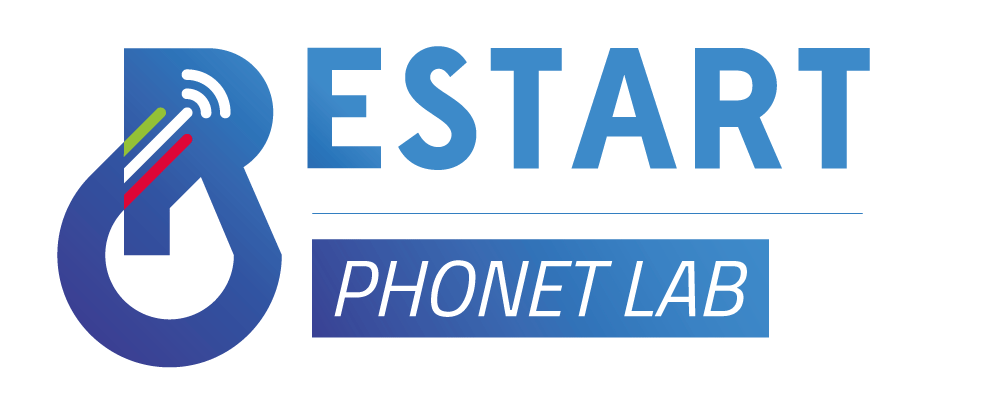
PHONET Lab - Optical/Network/Systems/Devices Photonet Lab.
Goal: design, prototype and demonstrate PoC for an end-to-end optical transport network with an innovative focus on the optical network segments that will support the future 6G infrastructure.
Involved technologies:
- Photonics integrated devices
- Optical systems
- Disaggregated Optical Networks
- Complete suite for disaggregated optical networks validation
- Complete validation cycle for PIC from design to characterization
- Zero touch optical network validation
- QKD-secured optical transmission
- Photonic applications for radio functionalities
- Open and disaggragated optical networks
- LiFi small cell demonstration
- Switch with coherent pluggable at 400Gb/s
- BTS Emulator Fronthaul/Backhaul
- Spirent traffic generator/analyzer at 100Gb/s
- Probe Station for Photonic IC
- Optical Spectrum Analyzer
- Real time oscilloscope
- Packaging machines
- Testing platform for disaggregated optical networks
- Packaging and characterization platform for PIC
- Optical systems test
- Zero-touch networks platforms
Reference Spoke: Spoke 1 - Pervasive and Photonic Network Technologies and Infrastructures
Involved RESTART projects: RIGOLETTO, HePIC, more to come...
Responsible people: Piero Castoldi, Marc Sorel - Scuola Superiore Sant'Anna di Pisa
Type of access: in person and, for dedicated cases, remotely
Expected time of full operability: T30
Synergic Labs:
- Department of Excellence in ICT and Robotics 2023-2027, SSSA, Pisa
- RESTART Labs @ Polito

SLICES Lab - Scientific Large Scale Infrastructure for Computing/Communication Experimental Studies.
Goals:
- Support post-5G experimentation
- Support experimentation in the cloud-to-edge continuum
- Link with relevant initiatives in the Quantum Internet area
- Post-5G disaggregated core, edge and RAN
- Resource-limited edge devices
- Quantum node
- Disaggregated post-5G open components
- Decentralised edge-based technologies
- Quantum Internet protocols
- Mobile networks @ edge, according to the PESCO use cases definition
- Complete HW for a post-5G disaggregated network
- O-RAN compliant SW
- Edge computing devices
- Quantum devices
- Experimentation on post-5G & edge computing environments
Reference Spoke: Spoke 1 - Pervasive and Photonic Network Technologies and Infrastructures
Involved RESTART projects: PESCO
Responsible people: Andrea Passarella - Consiglio Nazionale delle Ricerche
Type of access: Open
Expected time of full operability: T30
Synergic Labs: RESTART Spoke 4-5 Labs
Synergic Actions: SoBigData IR PNRR, SLICES ESFRI Research Infrastructure, NQSTI PE, SERICS PE
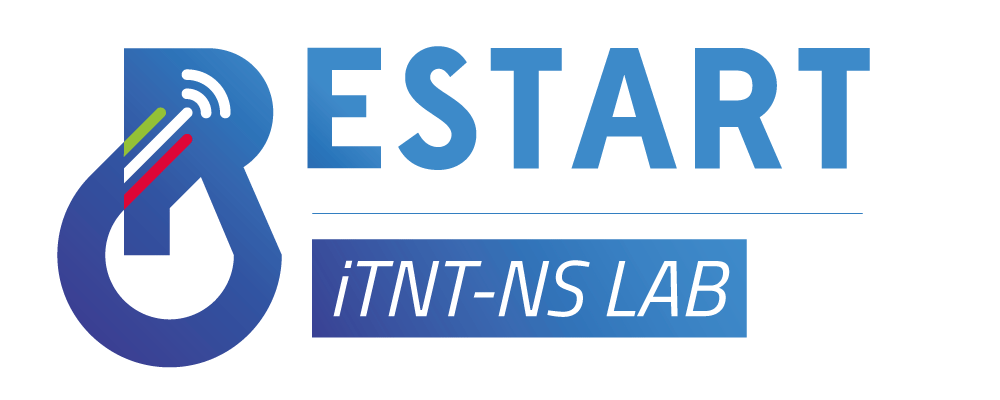
iTNT-NS Lab - Experimental Lab of Integrated Terrestrial and Non Terrestrial Networks & Services.
Goals:
- Design and investigation of the integration of terrestrial and non terrestrial networks and services through a 3-dimensional communication infrastructure
- Setting up heterogeneous Proof-of-Concepts
- Internet of Drones (IoD)
- Non-Terrestrial Networks (NTN)
- Integrated Terrestrial/Non-Terrestrial Networks (T/NTN)
- 5G and Beyond
- Innovative design and analysis of future wireless communication systems, based on the integration of Terrestrial and Non-Terrestrial Networks (T/NTN)
- Development of new standards for 6G and satellite-based communication systems
- Provision of enhanced experimental facilities in the South of Italy, with mid- and long-termvision for other future funding sources
- Emulation of integrated Terrestrial and Non-Terrestrial Networks
- 5G-enabled Internet of Drones scenarios
- Advanced services offered via 5G and Beyond
- Prototype of a mmWave system for communication and sensing in integrated Terrestrial and Non-Terrestrial architectures
- Workstations and advanced computing platforms
- Advanced network infrastructure with next-gen firewalls
- Terrestrial and Non-Terrestrial equipment (link emulator, terminals)
- End user devices (Programmable 5G COTS, IoT, drones, robots)
- Software defined-radio (SDR) platforms with mmWave TX/RX capability and radars
- Software: MATLAB, LabView, OpenAirInterface, ns-3, srsRAN, Linux, Visual Studio Code, Docker / Podman (all with custom features)
- New modules for open-source projects; Reconfigurable emulation and simulation frameworks for the test of advanced network infrastructures and services; Future Networks Training and Knowledge Transfer; Unique opportunities in the field of communication and teaching, promoting discussion initiatives between companies and students for the development of new ideas; Resources to tackle national and international projects, in line with the Strategic Research and Innovation Agenda 2021 – 2027, even after RESTART
Reference Spoke: Spoke 2 - Integration of Networks and Services
Involved RESTART projects: ITA NTN, Net4Future, ARCADIA
Responsible people: Luigi Alfredo Grieco, Giuseppe Piro - Politecnico di Bari
Industrial Partners: WindTre
Type of access: In person
Expected time of full operability: T24
Synergic Actions:
- Industrial Doctoral Network on Bridge Digitalised Integrity Management (BRIDGITISE)
- 6G Goal-Oriented AI-enabled Learning and Semantic Communication Networks (6G-GOALS)
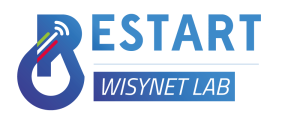
WISYNET Lab - Wireless System and Network Technologies.
Goals:
- Design and implement of innovative mmWave/Sub THz devices, their characterization and their introduction in 6G networks and, in particular, in vehicular communications (V2X)
- Investigation on biological effects that can be caused by new wireless technologies
- To evaluate the high frequency human exposure scenarios and to explore their biological effects
- To develop new radio architectures that comply with the challenging constraints dictated by novel smart radio environments with performance optimizations driven by AI procedures.
- Solutions for dealing with the new massive wireless connectivity
- Real 5G network (HFCLab)
- Measurements instruments operating between 3 and 110 GHz
- Radio and optical systems
- Open and virtualized Radio Access Networks operating at mmWave
- Lab for characterization of wireless devices operating between 3 and 110 GHz
- Lab for E.M. biological studies
- New Tx-Rx at Very High Frequency
- High Frequency Campus will adopt new wireless devices as smart repeaters and RIS Vehicular testing (V2X) in realistic dedicated environments
- Mobile airborne access points will be integrated within the High Frequency Campus
- 110GHz Vector Network Analyzer and mmWave signal generators/analyzers
- Controlled electromagnetic anechoic zone
- E.M Simulation tools: HFSS, CST, Feko, Exact, Armonica, 5G Matlab toolbox
- 5G Private network
- Characterization of active and passive components 3-110 GHz
- Vehicular testing (V2X) testing in realistic dedicated environments
- The High Frequency Campus at POLIMI provides an open environment where novel systems can be tested within a realistic scenario, including actual physical obstacles and interferers
- Evaluation of biological effects
Reference Spoke: Spoke 3 - Wireless Networks and Technologies
Responsible people: Francesco Matera - Fondazione Ugo Bordoni, Christian Mazzucco - Politecnico di Milano
Type of access: Open/Controlled
Expected time of full operability: T24
Synergic Labs:
- Next Generation Integrated Sensing and Analytical System for Monitoring and Assessing Radiofrequency Electromagnetic Field Exposure and Health – NEXTGEM (EU)
- Multilevel methodologies to investigate interactions between radiofrequencies and biological systems - MIRABILIS (PRIN)
- EMF Health Cluster - CLUE-H (EU)
- PNRR Serix (possible for security aspects)
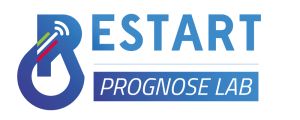
PROGNOSE Lab - Forging Future Networks and Applications: Seamless Adaptation, Empathetic Interactions in Tomorrow's Virtual Realms.
Goal: design, develop and evaluate algorithms, protocols, architectures and demonstrators for the programmable networks that will power tomorrow’s reconfigurable communication networks and highly demanding user services.
Involved technologies:
- Open Radio Access Network (O-RAN)
- eBPF
- Openflow
- Programming Protocol-independent Packet Processors (P4)
- In-line packet processing
- Software-defined networking (SDN)
- Open, virtualized, disaggregated, programmable RANs
- Zero-touch self-optimizing autonomous networks
- Virtual Network Functions (VNFs) placement algorithms
- E2E network orchestration
- 5G Non-Public Radio Access Networks (RANs) and User Equipments (UEs)
- Smart Network Interface Controllers (NICs)
- Programmable network fabric (Openflow, ONIE, P4 programmable switches)
- Development and testing platform for programmable networks
- GPU computing power for AI-based algorithms and innovative multimedia
- SUPER, FUN-Media, LEGGERO
Expected time of full operability: early 2025
Reference Spoke: Spoke 4 - Programmable Networks for Future Services and Media Responsible people: Fulvio Risso, Carla Fabiana Chiasserini, Enrico Magli - Politecnico di Torino

IDTN Lab - Industrial and Digital Transition Network Laboratory.
Goal
The Industrial Digital Transition Network (IDTN) Lab aims at designing, prototyping and demonstrating Proof of Concept (PoC) for 5G/6G Networks for Industrial Internet of Things with an innovative focus on testing 3D networks, including UAVs, AGVs and mini-cars, in the presence of smart environment, where Reconfigurable Intelligent Surfaces (RIS) are deployed, together with very high frequencies communication links.
Main equipment and software tools
- One UAV (optocopter) to be used for carrying a Base Station and four UAVs (quadricopter) carrying user equipments ;
- One OAI Box MINI, one OAI Box MAX, to be used as 5G Base Station, two smart phones and ten 5G USB dongle;
- Portable VNAs with extenders up to 110 GHz and Sub-THz signal generation and acquisition systems;
- Four Mini-cars with Wi-Fi and 5G air interfaces.
The laboratory will allow to perform the following Tests.
- 3D Networks:
This test allows to reproduce an outdoor industrial scenario, i.e., a large factory, where different kind of mobile devices are moving around for performing different tasks. They may be workers moving around, automated guided vehicles (AGV), used to move materials from different parts of the factory, Unmanned Aerial Vehicles (UAVs), to carry materials or take video, or finally, they may be cars. In all the cases the different User Equipments mounted on or carried by the different moving objects will need to have a good connection with the radio network in order to send / receive a huge amount of data (i.e., data generated by sensors, images, video, etc.). Connectivity will be provided by a fixed Base Station (BS) and a BS mounted on a UAV, to be used when non line-of-sight conditions are verified.
- High frequency Communication and WPT:
These tests will include two highly-flexible setups, made up by modular laboratory resources interconnected on the basis of reconfigurable architectures, which are aimed at executing experimental testing of electronic/opto-electronic components, as well as verifying the performance of low-latency communication links to be exploited in energy-autonomous wireless sensor networks for industrial network (IN) applications, possibly also including Radio-over-Fiber technologies. The two setups are intended for both signal and network characterization of IN components and communication links in two critical frequency bands, namely, a) the sub-THz region from 75 to 110 GHz in which to carry out the characterization of point-to-point wideband communication links, and b) a wide frequency range up to the low mm-wave frequencies (40 GHz) for testing components, protocols and radio channels in point to multi-point links.
- Coordination at intersection via V2X:
Four 1/10 scaled cars will be located on a circuit that features at least one intersection. The vehicles will be autonomous and connected, with communication protocols and control algorithms allowing them to adjust their speed so as not to stop at intersections. Vehicles will be equipped with a camera and a lidar, while for connectivity there will be direct connectivity between them and a road-side unit using the vehicular WiFi technology and possibly 5G connectivity towards an external controller.
Involved technologies:
- 5G/6G for Industrial networks
- Sub-THz communications
- Wireless Power Transfer at microwaves
- Reflective and Reconfigurable Intelligent Surfaces
- Testing outdoor Industrial context, including UAVs and AGVs
- Experimental characterization of Sub-THz communications
- New strategies for Wireless Power transmissions
- Testing Reflective and Reconfigurable Intelligent Surfaces
- Autonomous operation of UAVs and Mobile Robots in LoS and NLoS scenarios
- UAVs used as User Equipment and Base Station
- Mm-Wave BS on a roof
- UAVs and AGVs moving outdoor
- RIS on a building
Reference Spoke: Spoke 5 - Industrial and Digital Transition Networks Responsible people: Alessandro Vanelli-Coralli, Chiara Buratti - Università di Bologna Involved RESTART Projects: IN, MOSS, MoVeOver, RIGOLETTO
Type of access: In person Expected time of full operability: T24
Synergic Actions:
- HORIZON.2.4 - Digital, Industry and Space
- HORIZON-CL4-2022-SPACE
- PRIN 2022 PNRR
- CTE 2022 – MIMIT

MC2 Lab - Mission Critical Communications Laboratory.
Goal:
- Develop networking technologies with Key Value Indicators (KVI)s besides traditional KPIs
- Support Mission-Critical operations for marine wildlife monitoring, security and submersed cultural heritage monitoring
- Design and develop the first hybrid terrestrial/underwater platform for monitoring in Italy
- LPWAN (LoRa/LoRaWAN technologies)
- 5G and 6G communications technologies
- Digital Twins for networking
- V2X and UAV-based networks
- Acoustic underwater communications
- Develop and test innovative architectures integrating heterogeneous network segments and technologies
- Develop hybrid terrestrial/underwater communication systems
- Design and develop a multi-layer underwater communication system employing heterogeneous devices using a SDR approach
- Integrate the underwater technologies with LPWAN technologies to extend theunderwater network transmission range
- Demo about climate change parameters monitoring to be held in Chioggia, end of 2025
- Demo about marine wildlife conditions held in Area Marina Protetta, Isola dei Ciclopi, Acicastello, Catania, end 2024/mid 2025
- Demo about a smart city, Catania, end of 2024
- Underwater communications:
- 2 Evologics Acoustic modems S2CR18/34 and 4 Evologics SDM modems
- U8423054 V326-SU Immersion Transducers, 5 MHz, 0.375”
- Bluerobotics Blueboat surface drone
- Multi-interface underwater gateway nodes
- Software-defined low-cost modem equipment
- LUMA EX Optical underwater modems
- Platform for Digital Twin networks:
- Autonomous interconnected vehicle
- Flying Adhoc Network (FANET) with ten aerial drones, some of them equipped with 5G&B networking devices, others with high-resolution and multispectral video cameras
- O-RAN compliant Radio Access Network with edge-computing facilities
- Smart cities and communities services
- Underwater monitoring services at large
Reference Spoke: Spoke 6 - Innovative Architectures and Extreme Environments
Involved RESTART projects: COHERENT, SEXTET, AquaSmartt
Responsible people: Sergio Palazzo - Università di Catania
Type of access: Open access for RESTART community
Expected time of full operability: T30
Synergic Labs:
- CNIT RILTUS LAB@University of Catania
- Laboratori Nazionali del SUD/INFN Neutrino Mediterranean Observatory (NEMO) e KM3NeT-Italia

FABBRISS - National Facility for the Fabrication of RIS and Sensors for the Telecommunications of the Future.
Reference Spoke: Spoke 7 - Green and Smart Environments
Responsible people: Daniele Riccio - Università di Napoli Federico II
Type of access: Open access for RESTART community
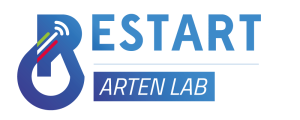
ARTEN Lab - Artificial Intelligence applied to telecommunication networks.
Laboratory dedicated to artificial intelligence aspects at all communication layers.
Assets: 5G Private Network, B5G Components, SDR Equipment, Cloud Facilities, Machine Learning Clusters, Spectrum Monitoring Equipment.
Expected Demos and Proofs of Concepts:
- Demonstration of Signal Coverage Improvement with a Reflective Surface at Villa Griffone
- Demonstration of Coverage Improvement with a smart skin installed at the University of Rome Tor Vergata
- Intelligent IoT devices for animal monitoring in Cayman Islands
- Security testing over 5G Open Source infrastructure
- Extraction and analysis of 5G and beyond uplink signals for the estimation of the number of User Equipments (UEs)
- Extraction and analysis of downlink signals from LEO Satellite Mega Constellations
- Intentional and not intentional RF interference detection and analysis in commercial or military applications
- Cloud Infrastructure for AI Tasks
- Bare metal server for HPC ML Tasks
- Fully Programmable SDR Devices
- Private 5G Network for Experimental Activities (Core + RAN at 3.5 GHz)
- I/Q receiver for ELINT sensing & monitoring
- Benchtop analyzer for intelligent signal analysis
- Cloud Infrastructure for Distributed AI Tasks
- HPC Server for Local AI Tasks
- Programmable Devices for Testing of Core and Radio 5G Functionalities
- IoT Energy Harvesting Nodes for testing and deployment of IoT services in rural environments
- Measurement devices for high fidelity RF monitoring & RF sensing
Reference Spoke: Spoke 8 - Intelligent and Autonomous Systems
Involved RESTART projects: Netwin, LIAISON, WITS, MOSS, ARCADIA
Responsible people: Luca Chiaraviglio - Università di Roma Tor Vergata
Type of access: remote and in person
Expected time of full operability: 2024
Synergic Labs: Joint demo activities at Villa Griffone with Spoke 5 UBO
Synergic Actions:
- Demo Facility for ERC Starting Grant FIND-OUT
- RF Measurement Infrastructure Sharing with PLAN-EMF Project
- IoT Infrastructure sharing with project "Innovative monitoring protocol for Cyclura nubila caymanensis on Cayman Brac"
Discover RESTART affiliated laboratories:
Inphotec - Integrated Photonics Technology center.
A fabrication and packaging facility for prototyping.
A fabrication and packaging facility for prototyping.
polifab - Micro and nano fabrication facility of Politecnico di Milano.
An aggregating center for academic researchers, start-ups and companies.
An aggregating center for academic researchers, start-ups and companies.
Photonic Devices - Photonic Devices Lab.
Characterization and testing of photonics devices.
Characterization and testing of photonics devices.
S2N - Smart and Secure Networks Laboratory.
Enabling cutting-edge experimental research on green and secure next generation mobile networks.
Enabling cutting-edge experimental research on green and secure next generation mobile networks.
